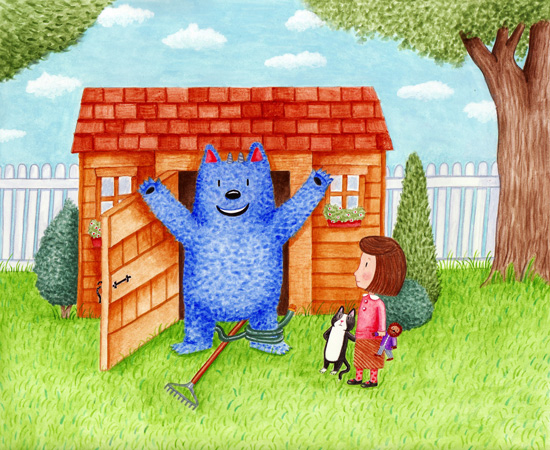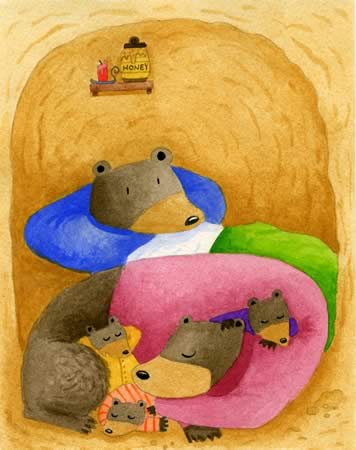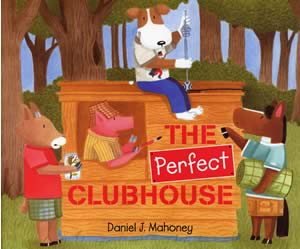I’m with Daniel Mahoney, a local illustrator who I first heard about from Frank Hodge, the legendary bookseller from Hodge-Podge Books in Albany. I ran into Daniel at a Planet Fitness (in our line of work, aerobic fitness is essential), and later at a book signing. But we’ve never officially hung out.
Quick story: We have a local organization, the Children’s Literature Connection, comprised of area teachers, librarians, authors and illustrators. Every once in a while I receive a postcard inviting me to an “Author’s Tea,” where the group presumably gets together, visits an artist’s studio, drinks tea (I’m guessing!), and, um . . . sings bawdy sea shanties? It’s probably a wonderful afternoon. But historically, I’m not much of a joiner. So I grumble, “Author’s tea? Invite me to an Author’s Beer and maybe I’ll show.” No hard feelings.
I mentioned this to Daniel, and he sympathized. So now we have plans, along with Jeffrey Scherer and Matt McElligott, to begin a new local tradition, sans tea.
Good morning, Daniel. Uh, dude, could you stop working and look at me? What’s on your drawing table right now?
I’m putting the finishing touches on the cover for a book proposal I’m about to send out. It’s titled, Monstergarten.
Great title. What’s it about?
It’s about a monster’s first day of school, and he’s nervous about the whole thing. The last painting I made was an interior illustration that I will be sending out with the dummy. It’s the opening scene of the book where the monster attempts to scare someone in preparation for his big day.
So that’s what it takes to sell a book? You have to send in a manuscript, book dummy, cover, and a sample of interior art?
When I send it to my agent, yes. She is in NYC as we speak (or type), showing it around. That’s pretty much the standard submission these days.
You still work as an X-ray technologist. Does that mean, like, you can tell what I just ate for breakfast?
I actually work only part-time as an X-ray technologist, so I can only see your eggs and toast on a part-time basis.
It still sounds gross. At what point did you decide to make the shift to children’s books? Was there a specific moment?
Well, I had been pondering about how to express myself with my art and earn a living at the same time. After not having any success publishing a comic strip in the newspaper, it hit me one day while shopping for my niece in a bookstore. As I perused the children’s section, I was in awe of all the beautiful books that people were creating for kids. I thought, I could do that, and knew right there and then that’s what I wanted to do.
Were you an artist as a child?
I’ve been drawing since I was three and a half years old, when my mother used to say I was the good one out of the three of us boys. I would sit with my crayons and paper at the coffee table while my brothers were out tormenting cats or whatever.
But you didn’t go to art school?
I did not go to art school. I’ve always loved to draw; and that’s key. I’ve been given a gift, and I’ve merely tried to take that gift as far as I can — and I continue to hone that gift and use it to the best of my ability. You never reach your “best” with art. You can always get better with constant practice and diligence.
I don’t know if you saw that I recently referenced a comment by James Marshall. He basically said that he was glad he never went to art school, because he felt it might take away his originality. Mark Teague is another guy I think of who was “self-taught,” as they say. There are probably many, many others.
Yes, I did see that, and it made me feel better about never going to art school. He makes a good point, and I’ll remember it every time I get stuck on a painting and wish I went to art school.
Your books earned some really nice reviews. The Saturday Escape and The Perfect Clubhouse were listed as Bank Street Best Children’s Books of the Year. A Really Good Snowman was named in a 2006 Kansas State Reading Circle Recommendation. That must have been enormously vindicating.
When my first three books came out, I was very new to the business. To tell you the truth, I never paid a lot of attention to that stuff. Now I appreciate what those acknowledgments mean.
Can we talk about your style a little bit? It’s so distinctive. I’m stumbling for words, because I don’t have the language to describe it. You have almost a folk-art approach, an old-timey sort of flatness to the composition. Am I making any sense at all?
Yes, perfect sense. My style arose from my knowledge (or lack thereof) of how to paint. I basically went to the art store and bought a bunch of watercolors because that’s what I noticed other children’s book illustrators using. I started experimenting with the paints, and gradually my style emerged. No instructor was there to tell me I was doing something right or wrong, so I just let loose with the brush. After much time and a lot of mistakes I developed a style that publishers seem to like.
Well, the style suits your subject matter. There’s a genuine warmth and gentleness to your stories. I saw that you recently attended the Rochester Children’s Book Festival. That sounds pretty cool. I never get invited anywhere.
I actually didn’t get invited. I asked the director if I could attend, and she said sure. I bet you could do the same.
I guess I’m like that shy guy at the roller rink, hoping that some girl with sweaty hands will ask me to skate during “Lady’s Choice.” It’s sad, really. I’m going to have to work up the courage.
It’s the third year I’ve been to the festival, and it just gets bigger and bigger every year. Last year they sold 35,000 books! Usually 35-45 authors and illustrators attend every year, including James Howe, Michelle Knudsen, Vivian Van Velde, and Paul O. Zelinsky, a personal hero whose artwork is sheer genius. I actually ate Indian food right next to him the night before the festival. He and a bunch of other authors and illustrators were staying in my hotel, so we just arranged this nice little outing to get to know each other. You have got to attend, Jimmy. Tell them I said so.
Okay, Lightning Round. Favorite children’s books?
Bedtime for Francis, The Nutshell Library by Maurice Sendak, Awful Ogre’s Awful Day, everything by Dr Suess.
I don’t know Awful Ogre. What’s special about that book?
It’s an awfully good book of poems, written by Jack Prelutsky and illustrated by Paul O. Zelinsky. It’s a book about grossness and yucky stuff in general that my four-year-old and I just eat up. These two masters of good, sick fun have created the funniest, most brilliant book about a day in the life of an awful ogre in all his disgusting glory.
Favorite musicians?
Fleetwood Mac, James Taylor, Eminem, The Cranberries.
That’s some diverse collection. I’d love to see them eat brunch together. You know, James Taylor asking Eminem to please pass the huevos rancheros and in return getting, like, stabbed in the neck with a fork, then the girl from the Cranberries writing a really mournful song about it.
But I digest. Top Movies?
Goodfellas, Raging Bull, Cinderella Man, Boys Don’t Cry, Halloween, Monster, Saving Private Ryan, Gladiator, The Incredibles, Ratatouille.
Dessert?
Chocolate cake — by a long shot.
Okay, Daniel. I can see the guy with the cue cards is waving frantically, so I guess our time is up. Thanks a lot. Good luck with Monstergarten. I’ll see you around.
Yes, we should have tea sometime.


















